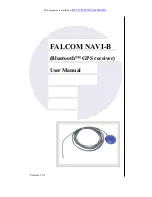
29
CH
Mute
Dim
Tracker
2
171.600 MHz
Got valid GPS data
Fil.
Figure 3
OPERATION
Figure 4
In any tracking environment, the GPS update rate of the beacon will have
an effect on the accuracy of the displayed target bearing. When both
vehicles are moving and the tracking vehicle is following too close, a
display indicating RDF bearing straight ahead and a GPS bearing of
straight behind may be generated (Figure 3). This condition is normal and
results from the tracking vehicle “over-driving” the beacons’ GPS waypoint.
To prevent this erroneous indication, the theoretical minimum following
distance (in feet) is calculated as follows:
(Speed in MPH X 5280) X (Rate of Beacon GPS update)
3600
Such that at 50 MPH times 5280, multiplied by 8 (Beacon update once
every 8 seconds)
Divided by 3600 = 586 feet (195 yards)
Based on GPS updates every 8 seconds (or even longer) be aware that on
interstate highways and similarly constructed roads it is possible to over-
run waypoints and miss exit ramps. Slight changes in the angle of the GPS
arrow may indicate exiting to an off ramp. Also the target vehicle may have
exited and is now located directly ahead on an over/under pass. Following
closer in complex or higher speed traffic pattern areas may be your only
safe guard to preventing loss of target. If unsure and with non-cloverleaf
highway exits, it may be prudent to take the exit, especially if the ramp
leads to an overpass or higher ground (Figure 4).
TIP:
Always maintain appropriate distance to the target based on the
traffic and speed. This will insure proper GPS operation and will allow
you to react to exit ramps and sudden turns. Pay attention to the RDF
Bearing in high speed highway traffic.
Summary of Contents for 5000
Page 1: ...RDF Pulse and GPS Enhanced Tracking System...
Page 29: ...35 NOTES...








































